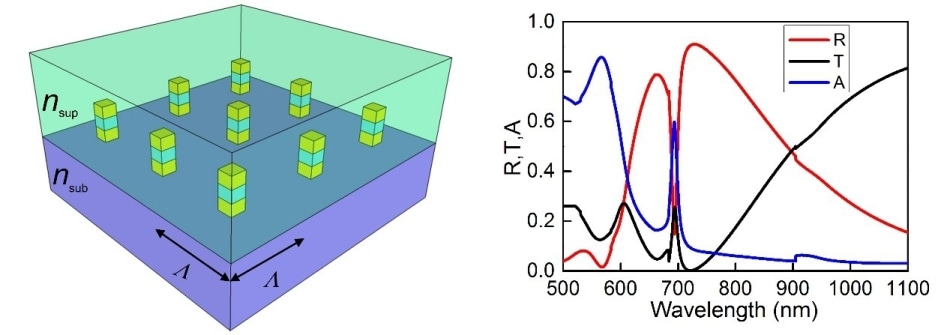Sep 5 2019
Plasmonic nanostructures have been extensively used for improving light-matter interactions because of the strong local field enhancement in deep subwavelength volumes.
 Novel SLR supported by MIM array and its Fano-shaped dip within a broad reflection spectrum. (Image credit: SIAT)
Novel SLR supported by MIM array and its Fano-shaped dip within a broad reflection spectrum. (Image credit: SIAT)
Propagating surface plasmon resonances (SPR) as well as localized surface plasmon resonances (LSPRs) are plagued by limited field enhancements and low-quality factors, resulting in limited performance in applications. By patterning metal nanoparticles in arrays, plasmonic surface lattice resonances (SLRs) can possess higher quality factors, lower radiation loss, and larger field enhancements over large volumes.
A study group guided by Dr LI Guangyuan and Dr LU Yuanfu from the Shenzhen Institutes of Advanced Technology (SIAT) of the Chinese Academy of Sciences described a novel type of SLR based on metal-insulator-metal (MIM) arrays. The paper, titled “Narrow plasmonic surface lattice resonances with preference to asymmetric dielectric environment,” was published on September 2nd, 2019 in Optics Express and was showcased as an Editor’s Pick.
Traditional SLRs are backed mostly by periodic metal nanoparticles and need a symmetric dielectric environment, that is, the superstrate and the substrate should possess the same refractive index. If the dielectric environment turns out to be less symmetric, SLR performance worsens radically. This significantly hampers the practical applications of SLRs particularly in optofluidic sensors, where it is hard to match the substrate’s refractive index with water or other fluids.
In this research, the scientists suggested a new SLR supported by a periodic MIM array and with a better quality factor in a less symmetric dielectric setting. They demonstrated that when the dielectric environment was as asymmetric as the air/glass environment, the recommended SLR had a high-quality factor of 62 under standard incidence and 147 under oblique incidence in the visible regime, or several times the highest quality factors of traditional SLRs under the identical conditions.
The researchers also demonstrated that an opto-microfluid sensing platform based on the recommended SLR under normal incidence (without optimization) had a figure of merit (FOM) of 25 and a sensitivity of 316 nm/RIU. This FOM is much greater than that of traditional SPR, LSPR, or SLR sensors.
The scientists believe that the SLR proposed by them, featuring higher quality factors in a less symmetric environment, is attractive for a wide range of applications such as nanolasers, ultrasensitive sensing, nonlinear optics, and modulators.